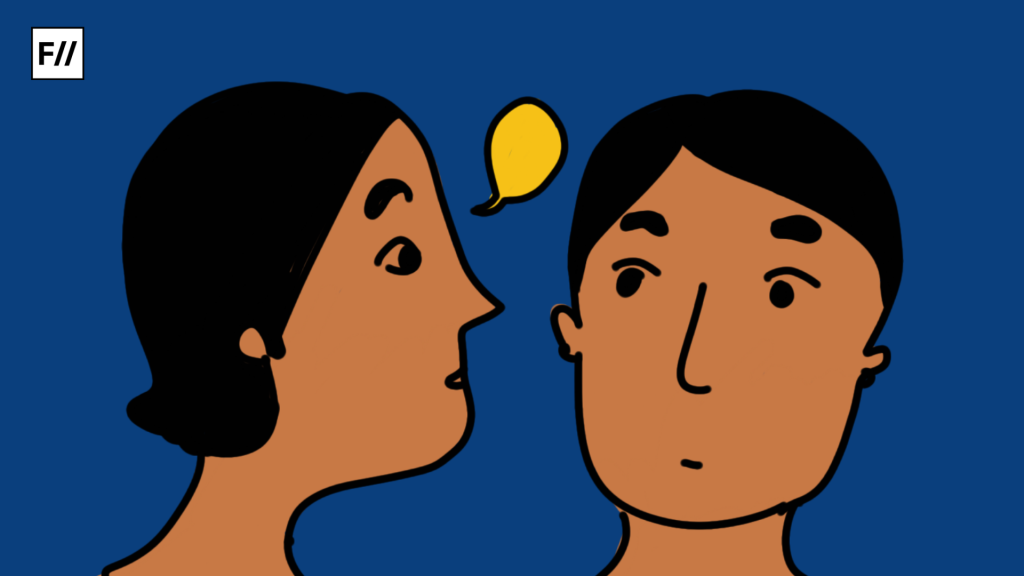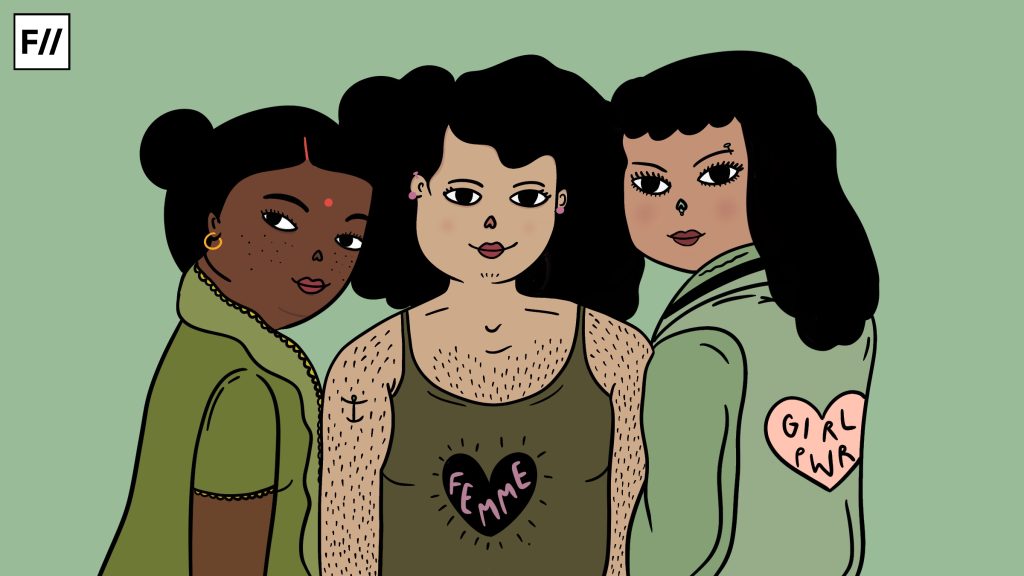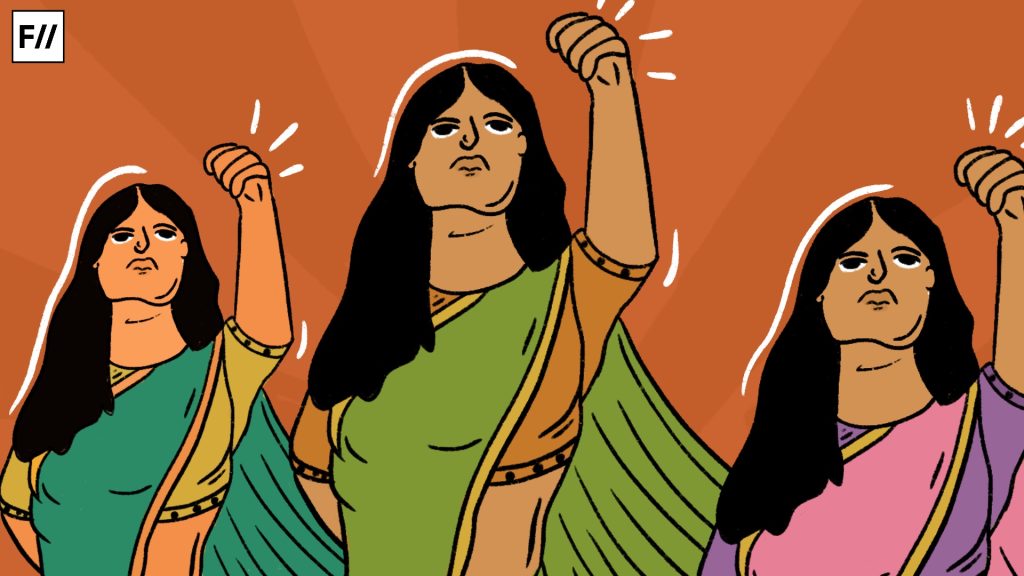If you know one thing about rap music, it is the street origins of the genre. Images of revolutionary rhymes emerging from urban underbellies, with assertive, red-blooded men battling it out to the beats, come to mind. So what do you get when you introduce the Queer Eye to a stage reserved for the sigma male?
Performing gender on the hip-hop stage
Now let a girl speak
2 hazar nakhun every week
How can she afford?
Kari mai hustle, batti pe me mange na bhik
— Kinari, Feminine Plural
While a certain liberal, urban demographic is slowly warming up to the existence of the LG&B, everything that starts and follows the T is still seen as elusively absurd and embarrassingly shameful. A major reason for this confusion, and consequent queerphobia, is the dominance of the idea that gender is a naturally constructed category. A man is a man because of the protrusion, and a woman is a woman because of the hole.

Mai thoda sa aisa glamorous kapde pehnti
Toh tum kya kya bolte ho
— Kinari, Charpai
But if we move beyond this somewhat amusing obsession with the phallus and start to genuinely engage with the absurd, we find that gender is more akin to an art than to a science. Judith Butler famously described gender as a ‘performance,‘ – a social ritual we participate in, acting out scripts written by prevailing norms of masculinity and femininity. One is not born a woman but becomes one, through learned stylisations of the body: the posture of the spine, the dance movements of gestures, the musical cadence of the voice.
Rapping in this accent cuz im listening to the voices ey
— Kinari, Memory Foam Heels
O rani rani ki hai chaal
— Kinari, Rock Bottom Parichit
The performance of gender through the aesthetics of hip-hop gives a mesmerising appeal to Dilli ki Rasili rapper, Kinari. The artist formerly known as FINSTA has been producing music since 2021. Her debut album Kattar Kinnar dropped this April, with thrilling sounds that play with samples of old Bollywood, the characteristic dhol from Delhi’s Khirki Extension, the Tamil Dalit community’s gaana music, and the thumris of mujra dancers. This vibrant playground serves as a backdrop to her effortlessly icy delivery of blazing-hot lyrics, making for a truly avant-garde album.
Apni pehchan experimental I got something to prove
— Kinari, Kadva Sach Mithi Bitch
The first track of the album is titled Kadva Sach Mithi Bitch, a phrase that captures the essence of Kattar Kinnar. Kinari fires barbed, stinging arrows of truth that cut through the performance of normalcy that we are accustomed to. The power of her artistic voice forces the listener into states of discomfort, shame, and self-consciousness because her very embodiment of gender as performance is provocative.
[embedded content]
cis women out here fakin it
dobara kahungi
cis women out here faking it
— Kinari, Memory Foam Heels
The gender-performance offers us the freedom to choose. It threatens the illusion of a stable, ‘natural,’ identity, inducing a sense of anxiety. And it is this anxiety which morphs into hatred and violence against the performance’s most visible manifestation: the transgendered body.
Awaaza, or the sound of trauma
Two months after Kattar Kinnar, we were gifted with the debut album of Hyderabad’s Dakhni rapper, Shehzor. ‘The Girl with Sideburns,’ is a khichdi of tabla beats, film dialogues, and a style of performance poetry reminiscent of the ghazal. But even though Shehzor’s inside jokes and signature cat ears, notes of trauma and abuse pierce the ear like a needle.

The fifth track of the album is titled Awaaza, a word that shows up repeatedly throughout the anthology. Awaaza is an unbearable noise: the sounds of crying, of fathers cursing their sons, intoxication, choking, shattered glass —
Khaali dhadkan ya sune aati nai
Awaaza hai har pal izhaar ich nai
— Shehzor, Awaaza
It is the sound of generational trauma that echoes throughout our dysfunctional communities. It is the inescapable pain of unfreedom and the torturous cage that forbids us from listening to our hearts.
Awaaza later makes an appearance in Pooch, a song based on the Islamic questioning of the dead. ‘The idea is that everyone will be questioned for 40 days about their deeds and sins. The way I was told this story as a kid was that there’s going to be an angel who will come down tearing into your grave, screaming the question mann rabbukaaaa? (Who is your Lord?)‘ Shehzor explained.
Duniya mei the jab tak jahaalat ke awaaza bas nai the kya?
abhi ya pe bhi aake woich sunara
arey bas hai awaaza
— Shehzor, Pooch
The screams of this angel resound in the background as Shehzor compares the grave to an interrogation chamber. The image is evocative of the never-ending trial of a Queer life – the endless questioning, the demands against its deviance. Not even Death can liberate us from this eternal torment.
‘How is the way of justice the same as the way of trauma and abuse? What are we supposed to make of that? I absolutely don’t want to go through anymore of this. I don’t care about your heaven or your hell. Just let death be the end,’ says Shezor.
The oppositional gaze
In 1992, American author bell hooks* published an insightful essay in which she ponders the power of the Gaze – from confrontational stares that children give to adults, to the punishment of enslaved people for the crime of looking at masters.

“All attempts to repress our (black peoples’) right to gaze had produced in us an overwhelming longing to look, a rebellious desire, an Oppositional Gaze. By courageously looking, we defiantly declared: ‘Not only will I stare. I want my look to change reality.‘”
— bell hooks, The Oppositional Gaze
hooks’ conception is that those who are oppressed by social structures learn to Look in a certain way to resist. This is part of the appeal of Kinari’s music to Queer hip-hop fans – a kattar view of heteronormative culture that makes for a vindictively liberating music experience. By displacing heteronormativity from its position as the default, she reveals the contradictions in this system that we consider ‘normal.’
Bande log mante jo Khud ko straight / Salary udate fir kinner pe bro, she raps in Madhuri. Straight men are the biggest consumers of “she-male porn” and the highest-paying customers of trans sex workers. But their attraction to trans-women conflicts with the performance of heterosexuality. This crisis of masculinity manifests in disproportionately high rates of violence, abuse, and rape against trans-women.
The Girl with Sideburns also twists the fabric of ideas that we hold sacred. Sabr ka phal aaya tak zabaan jalgayi, sings Shehzor in Waat (Story of Ayub). Patience is held as a holy ideal. But how much patience must we have in the face of an injustice that ruthlessly scars us? “You may say the fruits will be sweeter by the time you get there,” she says. “But what happens when your tongue is completely desensitised by the time you get that fruit? When you can’t appreciate the sweetness because of this prolonged torture?“
Both Kinari and Shehzor also share a disillusionment with mainstream hip-hop. Hiphop culture se anaath mai / (Lekin rahi uski atma meri haddi me) raps Kinari in Asli Girlpower. The roots of hip-hop were in protest against the brutality of States. But its commercialisation has clipped off its revolutionary claws.
‘There’s a quote by Paulo Freire, “When education is not liberating, the desire of the oppressed is to become the oppressor.’ That’s basically the genre of hip-hop entirely – oppressed people, through their words and energy, trying to portray themselves as as big as they truly feel inside. As strong, as manly, as powerful. But because of the kind of environment we live in, this manifests in images like luxury items, sexual exploits, and a capacity for violence,’” says Shehzor.
Gaana
In the face of unimaginably powerful forces, how do we find the strength to keep going?

The classic answer is Community. Kinari’s lyrics abound with a fierce love for her chosen family – Parivar chhod k Behne ko Chunu (Hijar) / Parivar saath me, People I chose (Madhuri). Shehzor’s Aamras Cuddles is an ode to joy and friendship. Yet, neither of them bears any illusions of a utopian saviour-ship that is increasingly ascribed to ‘community.’ Marginalised groups, in particular, are rife with systemic problems created by scarcity; which lead to individuals developing discordant defence mechanisms and prioritising their survival.
Paise ne sikhaya kaise dost b badle
Tabhi lage sare kinnar nirday
Kisi ko na farak Mare dusre ghar ke
Fuddi se kamate khali khud k kharche
— Kinari, Baahar
What Shehzor and Kinari turn to, then, is Art.
Kam se kam bane kala jab na hal dikhe
— Kinari, Gobbar Mitti (Memory Foam Garibi)
The Oppositional Gaze does more than react and resist; it also transforms and creates. It is the difference between Awaaza and Gaana. The power of Art is not a discharge of malignant moaning; but the cultivation of a Craft, the expression of the Self, and the transcendence of pain to create Beauty.
Summon the rain Tansen
Come on now kon bhi competition nai hai
Samandar mei jhaak dekh
Kon bhi tere kaabil nai hai
Mausam tera hai baraske khelna hai
Sharmake baadal ke pichche nai baithna
— Shehzor, Summon the Rain Tansen
*Gloria Jean Watkins used the pen-name bell hooks, deliberately stylised in lowercase
This post was originally published on this site be sure to check out more of their content.






